Abstract
We tested the in vitro susceptibility of Candida albicans to three defensins from human neutrophilic granulocytes (HNP-1, 2, and 3), a homologous defensin from rabbit leukocytes (NP-1), and four unrelated cationic peptides. Although the primary amino acid sequences of HNP-1, 2, and 3 are identical except for a single amino-terminal amino acid alteration, HNP-1 and HNP-2 killed C. albicans but HNP-3 did not. C. albicans blastoconidia were protected from HNP-1 when incubations were performed in the absence of oxygen or in the presence of inhibitors that blocked both of its mitochondrial respiratory pathways. Neither anaerobiosis nor mitochondrial inhibitors substantially protected C. albicans exposed to NP-1, poly-L-arginine, poly-L-lysine, or mellitin. Human neutrophilic granulocyte defensin-mediated candidacidal activity was inhibited by both Mg2+ and Ca2+, and was unaffected by Fe2+. In contrast, Fe2+ inhibited the candidacidal activity of NP-1 and all of the model cationic peptides, whereas Mg2+ inhibited none of them. These data demonstrate that susceptibility of C. albicans to human defensins depends both on the ionic environment and on the metabolic state of the target cell. The latter finding suggests that leukocyte-mediated microbicidal mechanisms may manifest oxygen dependence for reasons unrelated to the production of reactive oxygen intermediates by the leukocyte.
Full text
PDF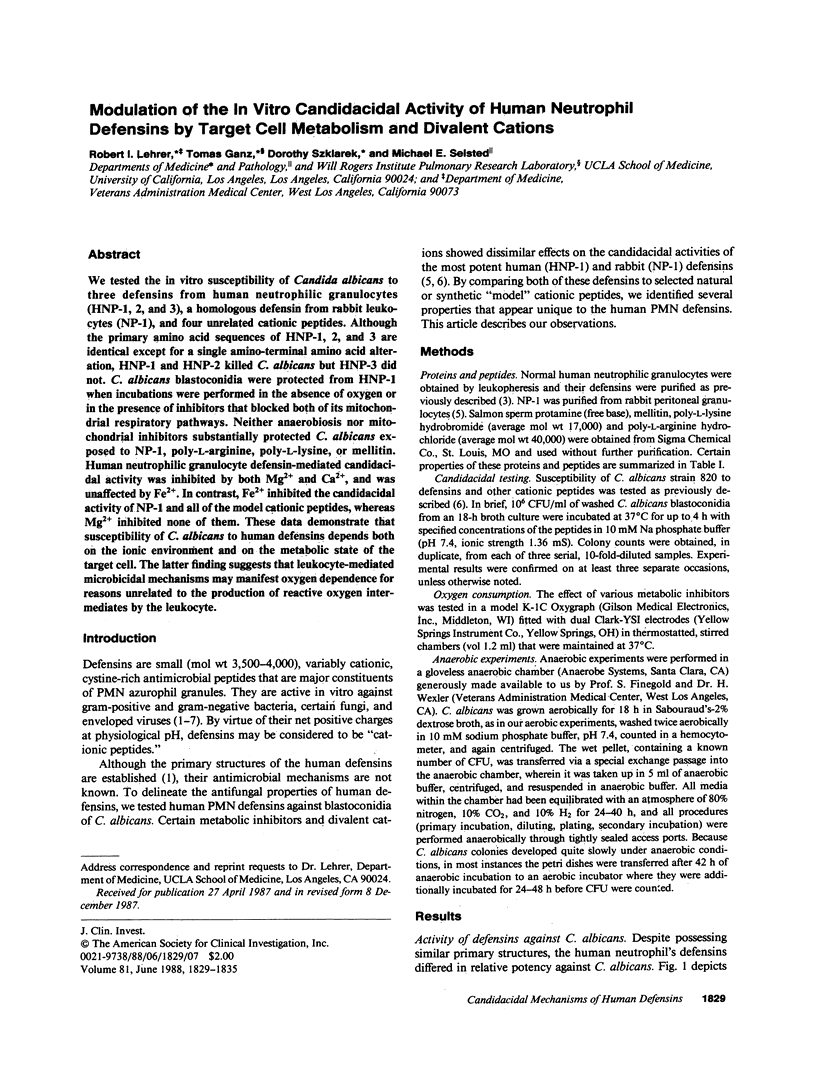
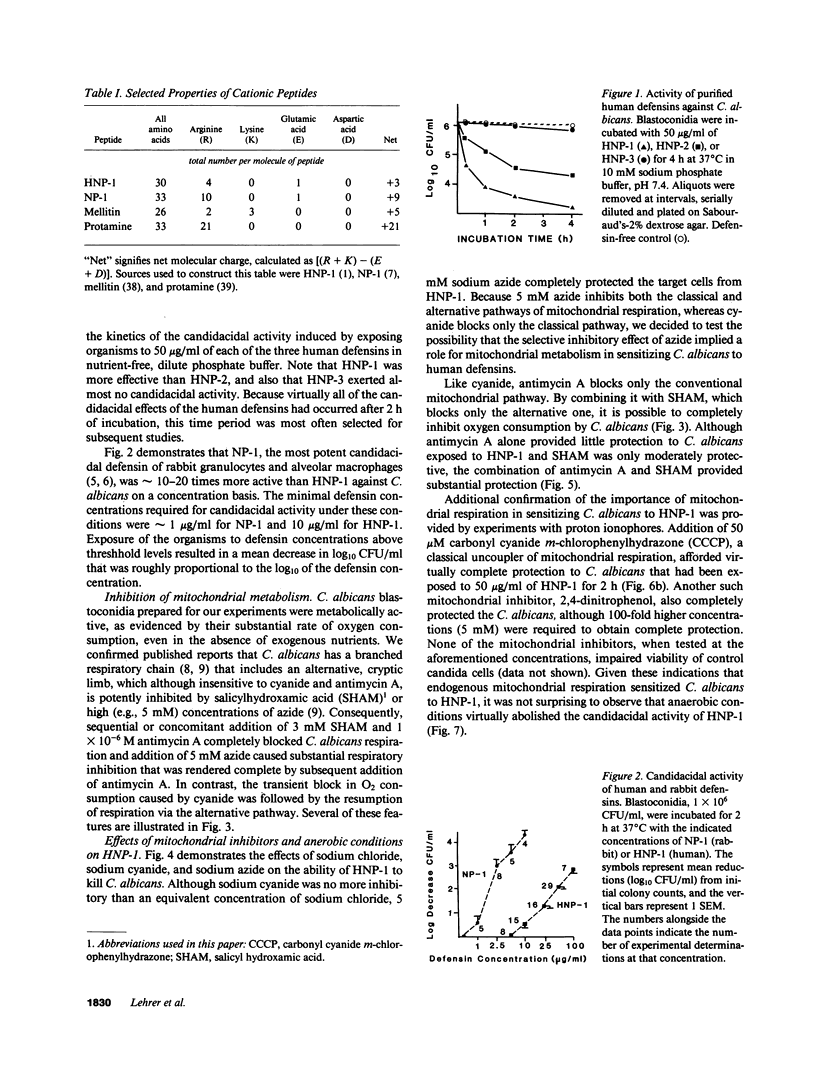
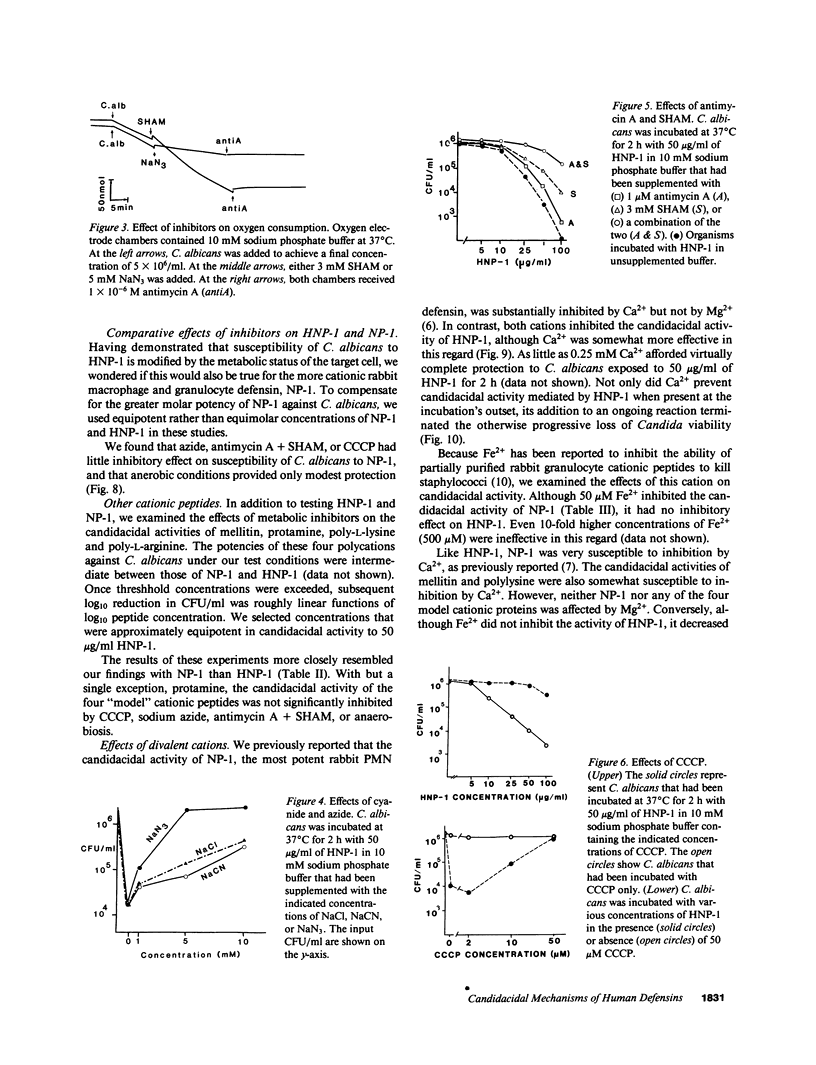
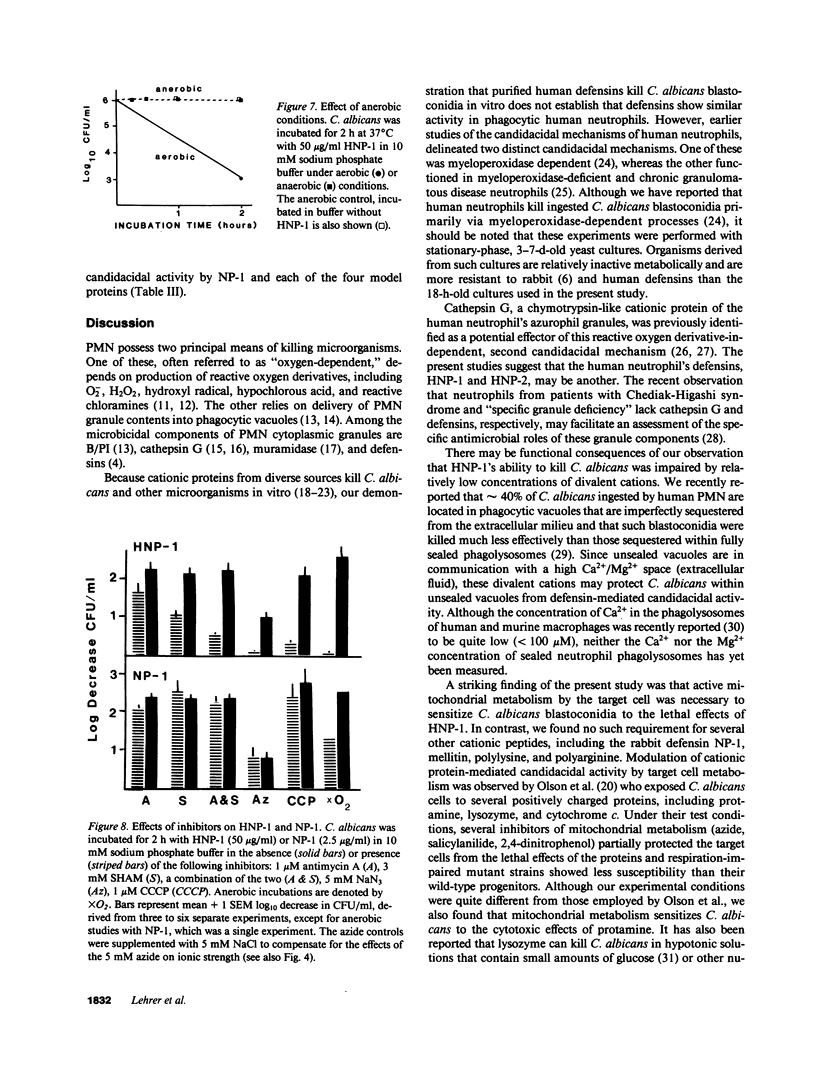
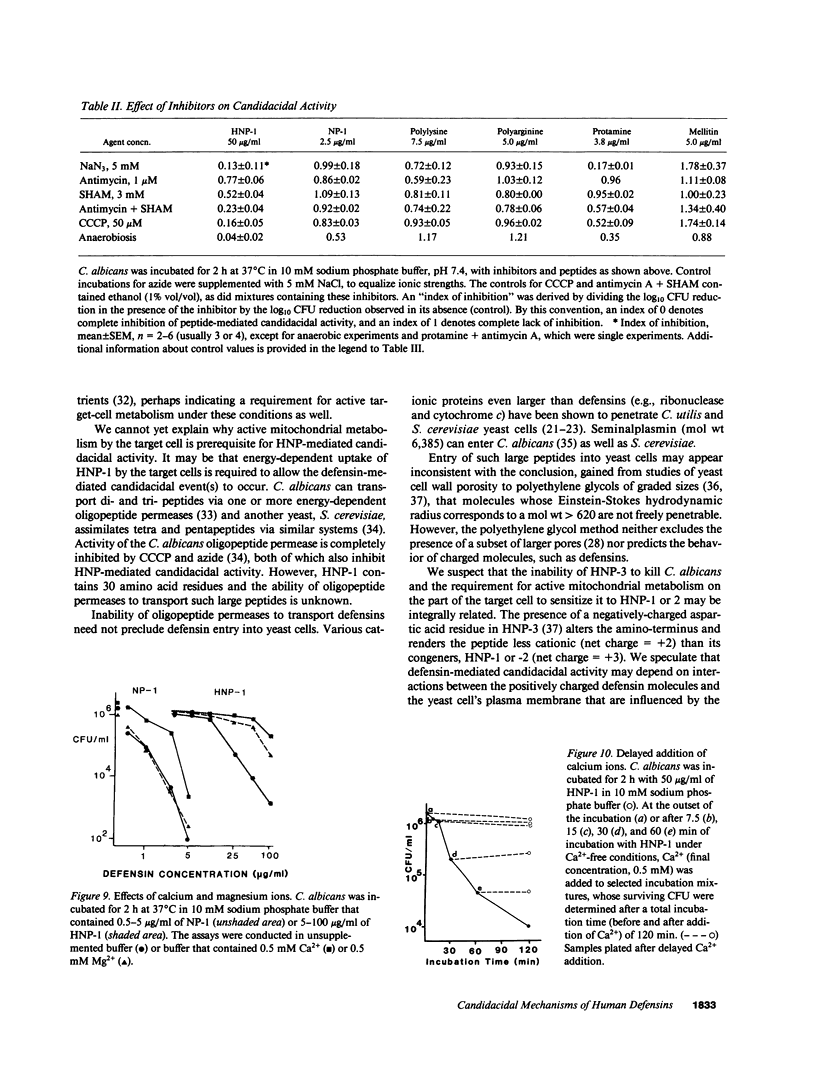
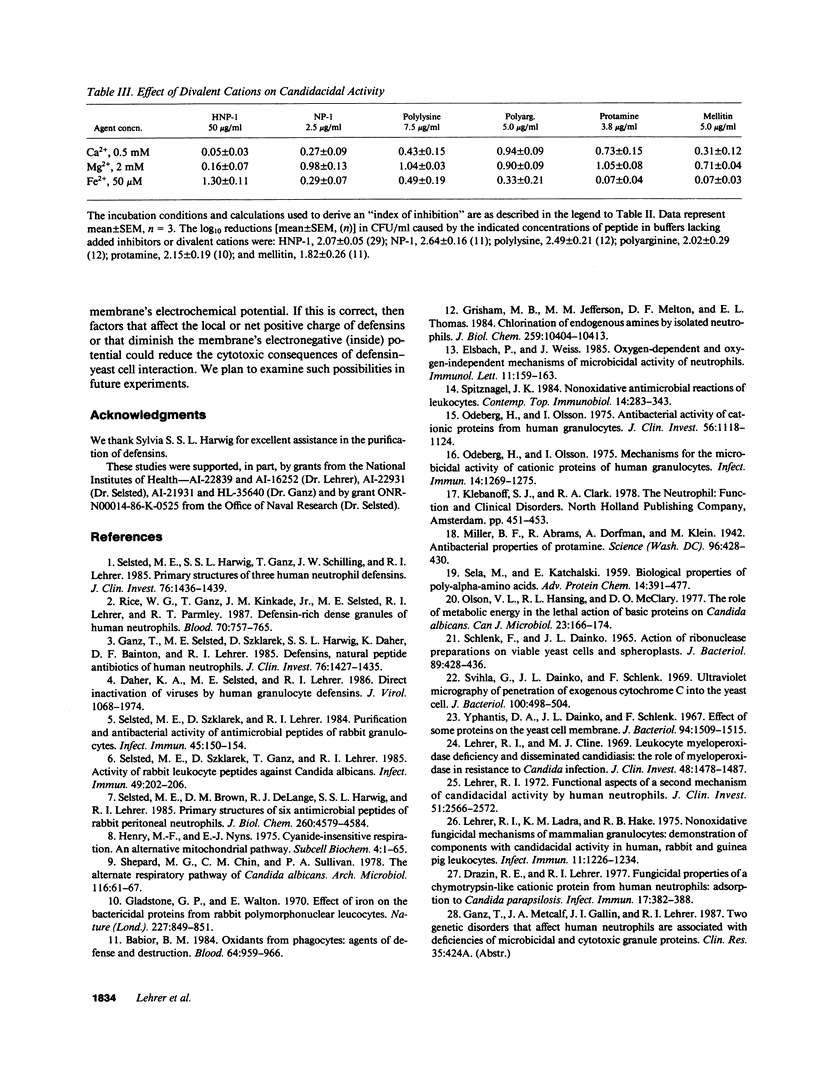
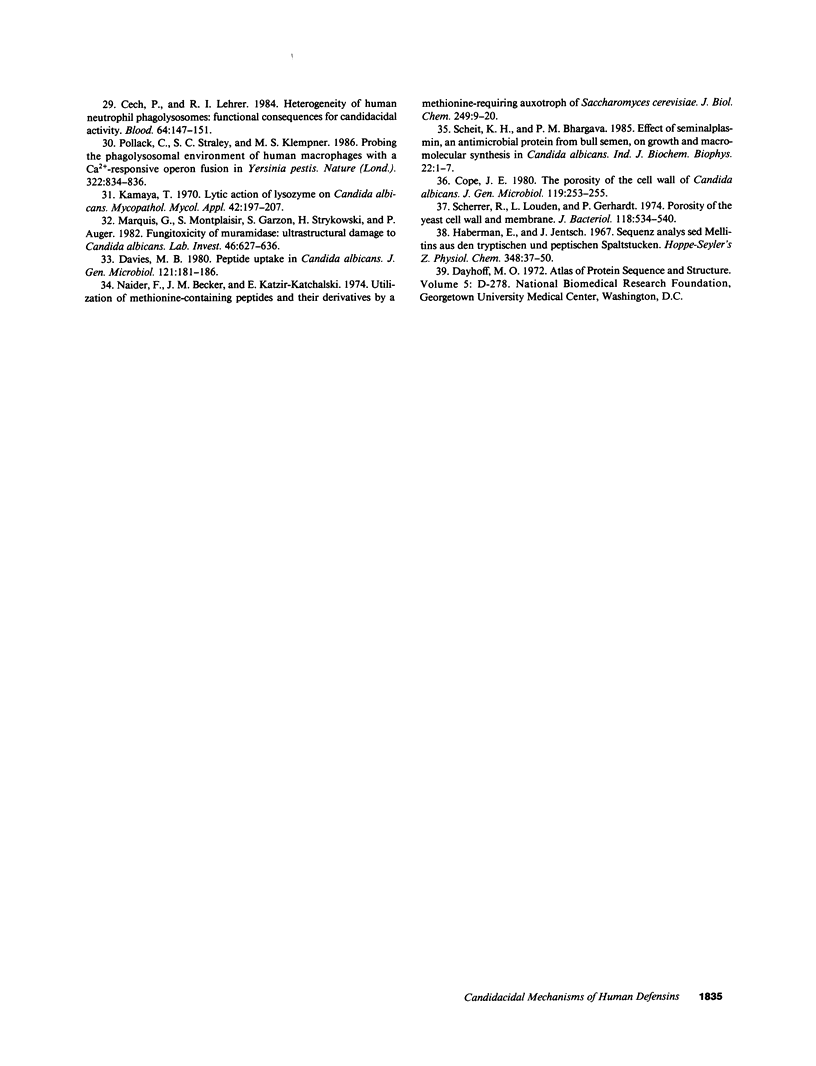
Images in this article
Selected References
These references are in PubMed. This may not be the complete list of references from this article.
- Babior B. M. Oxidants from phagocytes: agents of defense and destruction. Blood. 1984 Nov;64(5):959–966. [PubMed] [Google Scholar]
- Cech P., Lehrer R. I. Heterogeneity of human neutrophil phagolysosomes: functional consequences for candidacidal activity. Blood. 1984 Jul;64(1):147–151. [PubMed] [Google Scholar]
- Cope J. E. The porosity of the cell wall of Candida albicans. J Gen Microbiol. 1980 Jul;119(1):253–255. doi: 10.1099/00221287-119-1-253. [DOI] [PubMed] [Google Scholar]
- Daher K. A., Selsted M. E., Lehrer R. I. Direct inactivation of viruses by human granulocyte defensins. J Virol. 1986 Dec;60(3):1068–1074. doi: 10.1128/jvi.60.3.1068-1074.1986. [DOI] [PMC free article] [PubMed] [Google Scholar]
- Davies M. B. Peptide uptake in Candida albicans. J Gen Microbiol. 1980 Nov;121(1):181–186. doi: 10.1099/00221287-121-1-181. [DOI] [PubMed] [Google Scholar]
- Drazin R. E., Lehrer R. I. Fungicidal properties of a chymotrypsin-like cationic protein from human neutrophils: adsorption to Candida parapsilosis. Infect Immun. 1977 Aug;17(2):382–388. doi: 10.1128/iai.17.2.382-388.1977. [DOI] [PMC free article] [PubMed] [Google Scholar]
- Elsbach P., Weiss J. Oxygen-dependent and oxygen-independent mechanisms of microbicidal activity of neutrophils. Immunol Lett. 1985;11(3-4):159–163. doi: 10.1016/0165-2478(85)90163-4. [DOI] [PubMed] [Google Scholar]
- Ganz T., Selsted M. E., Szklarek D., Harwig S. S., Daher K., Bainton D. F., Lehrer R. I. Defensins. Natural peptide antibiotics of human neutrophils. J Clin Invest. 1985 Oct;76(4):1427–1435. doi: 10.1172/JCI112120. [DOI] [PMC free article] [PubMed] [Google Scholar]
- Gladstone G. P., Walton E. Effect of iron on the bactericidal proteins from rabbit polymorphonuclear leukocytes. Nature. 1970 Aug 22;227(5260):849–851. doi: 10.1038/227849a0. [DOI] [PubMed] [Google Scholar]
- Grisham M. B., Jefferson M. M., Melton D. F., Thomas E. L. Chlorination of endogenous amines by isolated neutrophils. Ammonia-dependent bactericidal, cytotoxic, and cytolytic activities of the chloramines. J Biol Chem. 1984 Aug 25;259(16):10404–10413. [PubMed] [Google Scholar]
- Habermann E., Jentsch J. Sequenzanalyse des Melittins aus den tryptischen und peptischen Spaltstücken. Hoppe Seylers Z Physiol Chem. 1967 Jan;348(1):37–50. [PubMed] [Google Scholar]
- Henry M. F., Nyns E. D. Cyanide-insensitive respiration. An alternative mitochondrial pathway. Subcell Biochem. 1975 Mar;4(1):1–65. [PubMed] [Google Scholar]
- Kamaya T. Lytic action of lysozyme on Candida albicans. Mycopathol Mycol Appl. 1970 Dec 29;42(3):197–207. doi: 10.1007/BF02051947. [DOI] [PubMed] [Google Scholar]
- Lehrer R. I., Cline M. J. Leukocyte myeloperoxidase deficiency and disseminated candidiasis: the role of myeloperoxidase in resistance to Candida infection. J Clin Invest. 1969 Aug;48(8):1478–1488. doi: 10.1172/JCI106114. [DOI] [PMC free article] [PubMed] [Google Scholar]
- Lehrer R. I. Functional aspects of a second mechanism of candidacidal activity by human neutrophils. J Clin Invest. 1972 Oct;51(10):2566–2572. doi: 10.1172/JCI107073. [DOI] [PMC free article] [PubMed] [Google Scholar]
- Lehrer R. I., Ladra K. M., Hake R. B. Nonoxidative fungicidal mechanisms of mammalian granulocytes: demonstration of components with candidacidal activity in human, rabbit, and guinea pig leukocytes. Infect Immun. 1975 Jun;11(6):1226–1234. doi: 10.1128/iai.11.6.1226-1234.1975. [DOI] [PMC free article] [PubMed] [Google Scholar]
- Marquis G., Montplaisir S., Garzon S., Strykowski H., Auger P. Fungitoxicity of muramidase. Ultrastructural damage to Candida albicans. Lab Invest. 1982 Jun;46(6):627–636. [PubMed] [Google Scholar]
- Miller B. F., Abrams R., Dorfman A., Klein M. ANTIBACTERIAL PROPERTIES OF PROTAMINE AND HISTONE. Science. 1942 Nov 6;96(2497):428–430. doi: 10.1126/science.96.2497.428. [DOI] [PubMed] [Google Scholar]
- Naider F., Becker J. M., Katzir-Katchalski E. Utilization of methionine-containing peptides and their derivatives by a methionine-requiring auxotroph of Saccharomyces cerevisiae. J Biol Chem. 1974 Jan 10;249(1):9–20. [PubMed] [Google Scholar]
- Odeberg H., Olsson I. Antibacterial activity of cationic proteins from human granulocytes. J Clin Invest. 1975 Nov;56(5):1118–1124. doi: 10.1172/JCI108186. [DOI] [PMC free article] [PubMed] [Google Scholar]
- Odeberg H., Olsson I. Mechanisms for the microbicidal activity of cationic proteins of human granulocytes. Infect Immun. 1976 Dec;14(6):1269–1275. doi: 10.1128/iai.14.6.1269-1275.1976. [DOI] [PMC free article] [PubMed] [Google Scholar]
- Olson V. L., Hansing R. L., McClary D. O. The role of metabolic energy in the lethal action of basic proteins on Candida albicans. Can J Microbiol. 1977 Feb;23(2):166–174. doi: 10.1139/m77-024. [DOI] [PubMed] [Google Scholar]
- Pollack C., Straley S. C., Klempner M. S. Probing the phagolysosomal environment of human macrophages with a Ca2+-responsive operon fusion in Yersinia pestis. 1986 Aug 28-Sep 3Nature. 322(6082):834–836. doi: 10.1038/322834a0. [DOI] [PubMed] [Google Scholar]
- Rice W. G., Ganz T., Kinkade J. M., Jr, Selsted M. E., Lehrer R. I., Parmley R. T. Defensin-rich dense granules of human neutrophils. Blood. 1987 Sep;70(3):757–765. [PubMed] [Google Scholar]
- SCHLENK F., DAINKO J. L. ACTION OF RIBONUCLEASE PREPARATIONS ON VIABLE YEAST CELLS AND SPHEROPLASTS. J Bacteriol. 1965 Feb;89:428–436. doi: 10.1128/jb.89.2.428-436.1965. [DOI] [PMC free article] [PubMed] [Google Scholar]
- SELA M., KATCHALSKI E. Biological properties of poly-alpha-amino acids. Adv Protein Chem. 1959;14:391–478. doi: 10.1016/s0065-3233(08)60614-2. [DOI] [PubMed] [Google Scholar]
- Scheit K. H., Bhargava P. M. Effect of seminalplasmin, an antimicrobial protein from bovine semen, on growth and macromolecular synthesis in Candida albicans. Indian J Biochem Biophys. 1985 Feb;22(1):1–7. [PubMed] [Google Scholar]
- Scherrer R., Louden L., Gerhardt P. Porosity of the yeast cell wall and membrane. J Bacteriol. 1974 May;118(2):534–540. doi: 10.1128/jb.118.2.534-540.1974. [DOI] [PMC free article] [PubMed] [Google Scholar]
- Selsted M. E., Brown D. M., DeLange R. J., Harwig S. S., Lehrer R. I. Primary structures of six antimicrobial peptides of rabbit peritoneal neutrophils. J Biol Chem. 1985 Apr 25;260(8):4579–4584. [PubMed] [Google Scholar]
- Selsted M. E., Harwig S. S., Ganz T., Schilling J. W., Lehrer R. I. Primary structures of three human neutrophil defensins. J Clin Invest. 1985 Oct;76(4):1436–1439. doi: 10.1172/JCI112121. [DOI] [PMC free article] [PubMed] [Google Scholar]
- Selsted M. E., Szklarek D., Ganz T., Lehrer R. I. Activity of rabbit leukocyte peptides against Candida albicans. Infect Immun. 1985 Jul;49(1):202–206. doi: 10.1128/iai.49.1.202-206.1985. [DOI] [PMC free article] [PubMed] [Google Scholar]
- Selsted M. E., Szklarek D., Lehrer R. I. Purification and antibacterial activity of antimicrobial peptides of rabbit granulocytes. Infect Immun. 1984 Jul;45(1):150–154. doi: 10.1128/iai.45.1.150-154.1984. [DOI] [PMC free article] [PubMed] [Google Scholar]
- Shepherd M. G., Chin C. M., Sullivan P. A. The alternate respiratory pathway of Candida albicans. Arch Microbiol. 1978 Jan 23;116(1):61–67. doi: 10.1007/BF00408734. [DOI] [PubMed] [Google Scholar]
- Spitznagel J. K. Nonoxidative antimicrobial reactions of leukocytes. Contemp Top Immunobiol. 1984;14:283–343. doi: 10.1007/978-1-4757-4862-8_10. [DOI] [PubMed] [Google Scholar]
- Svihla G., Dainko J. L., Schlenk F. Ultraviolet micrography of penetration of exogenous cytochrome c into the yeast cell. J Bacteriol. 1969 Oct;100(1):498–504. doi: 10.1128/jb.100.1.498-504.1969. [DOI] [PMC free article] [PubMed] [Google Scholar]
- Yphantis D. A., Dainko J. L., Schlenk F. Effect of some proteins on the yeast cell membrane. J Bacteriol. 1967 Nov;94(5):1509–1515. doi: 10.1128/jb.94.5.1509-1515.1967. [DOI] [PMC free article] [PubMed] [Google Scholar]



